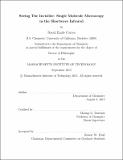| dc.contributor.advisor | Moungi G. Bawendi. | en_US |
| dc.contributor.author | Correa, Raoul Emile | en_US |
| dc.contributor.other | Massachusetts Institute of Technology. Department of Chemistry. | en_US |
| dc.date.accessioned | 2014-01-23T17:11:44Z | |
| dc.date.available | 2014-01-23T17:11:44Z | |
| dc.date.copyright | 2013 | en_US |
| dc.date.issued | 2013 | en_US |
| dc.identifier.uri | http://hdl.handle.net/1721.1/84170 | |
| dc.description | Thesis (Ph. D.)--Massachusetts Institute of Technology, Dept. of Chemistry, 2013. | en_US |
| dc.description | This electronic version was submitted by the student author. The certified thesis is available in the Institute Archives and Special Collections. | en_US |
| dc.description | Cataloged from student-submitted PDF version of thesis. | en_US |
| dc.description | Includes bibliographical references (pages 95-106). | en_US |
| dc.description.abstract | Infrared-active nanostructures play an increasingly important role in the nanoscience toolbox, yet little is known about their optical properties at the single nanoparticle level. In this thesis, we detail efforts to extend the power of single-molecule spectroscopy into the shortwave-infrared (SWIR), marrying confocal microscopy with superconducting nanowire single photon detectors that operate very eciently in this portion of the spectrum. As a proof of principle, we interrogate single lead sulfide (PbS) nanocrystals emitting at 1100 nm and observe fluorescence intermittency (blinking) under continuous excitation. The extracted on/o waiting-time statistics were power-law distributed, with exponents nearly identical to those measured from visible NCs. In addition, we demonstrate the feasibility of performing sophisticated photon correlation experiments on weak SWIR emitters and confirm that the photoluminescence from single PbS NCs displays sub-Poissonian photon statistics, strong evidence for single-NC localization. Next, we use our unique apparatus to probe two key steps in the exciton lifecycle of single 1300-nm-emitting indium arsenide nanocrystals: the time evolution, and subsequent recombination, of single and multiple excitons. Upon correlating PL intensity with the lifetime decay, we discover that InAs/CdZnS nanocrystals blink in one of two ways, either with the PL decay rate fluctuating simultaneously or remaining constant for all PL intensities other than the o state. Surprisingly, we observe grey-state emission - commonly attributed to trion recombination - with a PL lifetime nearly equal to the bright state (attributed to neutral exciton recombination). For the 21 NCs studied, we observe signicant heterogeneity in single-NC radiative lifetimes (47 to 179 ns), while simultaneously measuring a near-zero biexciton quantum yield across the sample. Finally, we perform single-NC spectroscopy on a new generation of CdSe/CdS nanocrystals and extract kinetic rates of recombination for both neutral and charged excitons, which we assign to the bright and grey state respectively. By correlating the instantaneous PL lifetime with the PL intensity using fluorescence-lifetime-intensity-distribution (FLID) plots, we assess the prospects of alternative blinking mechanisms in 2-monolayer and 7-monolayer CdSe/CdS NCs, as well as QD Corp. NCs (QDC655), and nd little evidence for anomalous blinking (i.e. the recently proposed Type B blinking) for all three NC systems. | en_US |
| dc.description.statementofresponsibility | by Raoul Emile Correa. | en_US |
| dc.format.extent | 106 pages | en_US |
| dc.language.iso | eng | en_US |
| dc.publisher | Massachusetts Institute of Technology | en_US |
| dc.rights | M.I.T. theses are protected by
copyright. They may be viewed from this source for any purpose, but
reproduction or distribution in any format is prohibited without written
permission. See provided URL for inquiries about permission. | en_US |
| dc.rights.uri | http://dspace.mit.edu/handle/1721.1/7582 | en_US |
| dc.subject | Chemistry. | en_US |
| dc.title | Seeing the invisible : single molecule microscopy in the shortwave infrared | en_US |
| dc.title.alternative | Single molecule microscopy in the shortwave infrared | en_US |
| dc.type | Thesis | en_US |
| dc.description.degree | Ph.D. | en_US |
| dc.contributor.department | Massachusetts Institute of Technology. Department of Chemistry | |
| dc.identifier.oclc | 867634923 | en_US |
